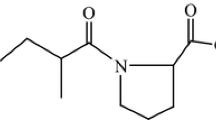Abstract
The stability of captopril in aqueous solution at 32°C was studied in the pH range 6.6 to 8.0 under controlled oxygen partial pressure (90–760 mm Hg) with and without the addition of cupric ion. The oxidation product, captopril disulfide, was found to be the sole degradation product. A change in reaction rate from first order to zero order occurs as the captopril concentration decreases. The concentration at which this transition takes place is a function of the pH, oxygen partial pressure, and cupric ion concentration. The apparent first-order rate constants show a first-order dependency on both the oxygen partial pressure and the cupric ion concentration. However, the apparent zero-order rate constants show a first-order dependency on oxygen partial pressure and a second-order dependency on cupric ion concentration. As the pH increases from 6.6 to 8.0, the first-order process becomes more predominant. A mechanism which consists of cupric ion- and molecular oxygen-catalyzed oxidation is proposed to explain those observations.
Similar content being viewed by others
REFERENCES
D. W. Cushman, H. S. Cheung, E. F. Sabo, and M. A. Ondetti. Biochemistry 16:5484–5491 (1977).
R. K. Ferguson, H. R. Brunner, G. A. Turini, H. Gavras, and D. N. McKinstry. Lancet 1:775–778 (1977).
P. Timmins, I. M. Jackson, and Y. J. Wang. Int. J. Pharm. 11:329–336 (1982).
Y. Kawahara, M. Hisaoka, Y. Yamazaki, A. Inage, and T. Morioka. Chem. Pharm. Bull. 29:150–157 (1981).
H. Kadin, Captopril. In Analytical Profiles of Drug Substances, Vol. 11, American Pharmaceutical Association, Washington, D.C., 1982, pp. 79–137.
T. D. Sokoloski and T. Higuchi. J. Pharm. Sci. 51:172–177 (1962).
D. D. Perrin and B. Dempsey. Buffers for pH and Metal Ion Control, Chapman and Hall, New York, 1974.
T. J. Wallace and A. Schriesheim. J. Org. Chem. 27:1514–1516 (1962).
T. J. Wallace and A. Schriesheim. Tetrahedron 21:2271–2280 (1965).
T. J. Wallace, A. Schriesheim, and W. Bartok. J. Org. Chem. 28:1311–1314 (1963).
C. F. Cullis, J. D. Hopton, and D. L. Trimm. J. Appl. Chem. 18:330–335 (1968).
E. G. Rippie and T. Higuchi. J. Pharm. Sci. 51:626–630 (1962).
E. G. Rippie and T. Higuchi. J. Pharm. Sci. 51:776–779 (1962).
T. J. Wallace, A. Schriesheim, H. Hurwitz, and M. B. Glaser. Ind. Eng. Chem. Process Des. Dev. 3:237–241 (1964).
C. F. Cullis, J. D. Hopton, C. J. Swan, and D. L. Trimm. J. Appl. Chem. 18:335–339 (1968).
C. J. Swan and D. J. Trimm. J. Appl. Chem. 18:340–344 (1968).
H. Nord. Acta Chem. Scand. 9:430–435 (1955).
M. L. Hitchman. Measurement of Dissolved Oxygen, John Wiley & Sons, New York, 1978.
Author information
Authors and Affiliations
Rights and permissions
About this article
Cite this article
Lee, TY., Notari, R.E. Kinetics and Mechanism of Captopril Oxidation in Aqueous Solution Under Controlled Oxygen Partial Pressure. Pharm Res 4, 98–103 (1987). https://doi.org/10.1023/A:1016406716989
Issue Date:
DOI: https://doi.org/10.1023/A:1016406716989




